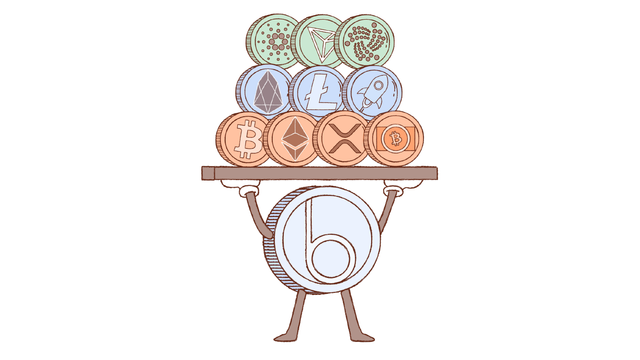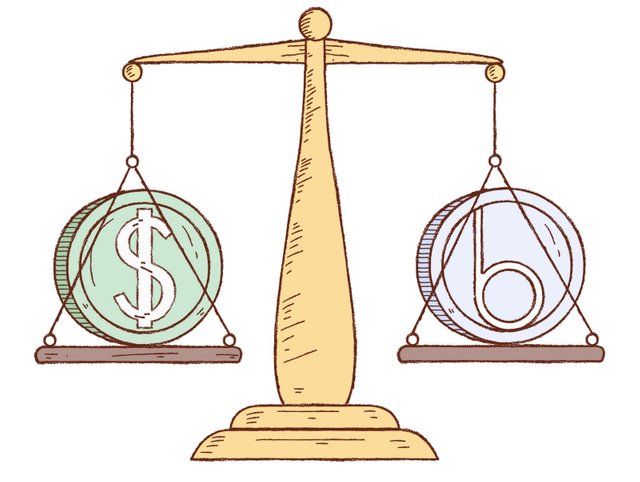Looking to Provide the Stability Crypto Needs
You may not have heard of the year-old startup known as Basis. But the cryptocurrency company based out of Hoboken, New Jersey has roared out of the ICO gates and raised over $133 million in the past year to go toward creating a new stablecoin for the masses. The token (formerly known as Basecoin) is a stablecoin that is programmed to maintain its value closely to the value of one US dollar at all times. In cryptocurrency, it is not always a practical or available option to simply trade Bitcoin for dollars and vice versa. Basis works to solve this problem. The Basis team explains,
“Cryptocurrencies have been too volatile for mainstream use. Loans, salaries, and other basic financial contracts are poorly served by volatile currency.”

The soon to be public non-collateralized stable token, founded by Nader Al-Naji, utilizes an algorithmic bank embedded in its code. This algorithm sets out to:
- Buy back Basis tokens when demand falls in order to shrink its supply
- Sell off Basis tokens when demand rises in order to inflate its supply
- By doing both of the above, the algorithm can optimally maintain that one Basis token is equal to one US dollar at all times.
Although Basis will peg itself to the US dollar, it has plans to peg to a consumer price index once mass adoption is achieved and it is (hopefully) being regularly used to make real life purchases of goods and services. In a discussion with Josh Chen, a co-founder at Basis, he stated,
“Basis is designed to offer a fully-decentralized, counterparty-free system to users, independent from any centralized source of value in the long term. Bitcoin has shown that users find real value in the safety of a decentralized cryptocurrency. We think users will find similar value in Basis, but with added stability regulated by its algorithmic central bank.”
Founder Nader Al-Naji, a former Bitcoin miner during the early years of cryptocurrency in 2012, has received tremendous backing for his revolutionary idea to create a coin that algorithmically adjusts its own supply as needed. The coin is intriguing not only for its uniqueness among other stablecoins, but also for its designed purpose of being a consistent force in such a volatile market.To give an idea of the excitement surrounding Basis, a large chunk of their money raised came from the likes of GV (previously known as Google Ventures), Bain Capital Ventures, fed reserve governor Kevin Warsh, and Lightspeed Venture Partners. Investors know there is a major market opportunity for a coin like Basis, which offers a stable store of value in an otherwise heavily turbulent field. According to the Basis website,
“Basis is designed to maintain a stable value and serve as a medium of exchange accessible to anyone with an internet connection.”
Theoretically, this means that the only thing separating it from that green paper money sitting in your wallet is having an active connection to the world wide web. With one Basis coin equalling one US dollar, it has the potential to be used as an alternative to purchase goods and services. If the coin actually establishes itself as a relied upon currency that can be used without significant fluctuations from its intended value, then this will be a big deal for the future and mainstream usage of cryptocurrency as a whole.
Trust Issues
The designed purpose of Basis (pegging its value to the dollar) is the same as other already existing popular stablecoins like Tether (USDT) and True USD (TUSD). These coins have been circulating through exchanges as relatively easy ways to convert one’s Bitcoin or other altcoin holdings into something stable while circumventing FIAT central banks. However, there has been a lack of proof in fund backing for USDT, as well as slightly wavering values that stray away from the dollar in both coins’ histories. As a result, exchanges have seen many traders avoid these coins as options to stabilize their portfolios. There has instead been an increased demand for regular USD trading pair options on popular trading sites. But is this really what is best for the future of cryptocurrency?

Cryptocurrency may eventually rest on the viability of stablecoins like Basis.
This lack of trust in the relatively new existence of stablecoins is precisely what is holding back cryptocurrency from separating itself from the Federal Reserve and central banks as a viable alternative to traditional currency. The struggles and controversies other stablecoins like Tether (USDT) have experienced in trying to make a name for themselves have opened up the door for Basis to become the first reliable dollar-pegged coin if they can accomplish what they hope to do. And if Basis does succeed, it will be a concern for the Federal Reserve’s monetary policy.Andrea O’Sullivan, an analyst at CoinCenter, points out that there is:
“fear that if cryptocurrencies are adopted on a wide enough scale, it could have a negative externality, or spillover effect, on the economy as a whole in the form of monetary instability.”
Her article goes on to explain that $100 billion of Bitcoin’s market cap only accounts for 1.3% of the world’s actual hard Fiat currency. Therefore, it is fairly unlikely that Bitcoin or another cryptocurrency coin actually makes a dent in the US dollar, Euro, or another major currency any time soon. However, 1.3% is not nothing. And as more people eventually adopt crypto as a means for making legitimate transactions, there will come a time where the Fed will need to actually take Bitcoin and others seriously. Stablecoins such as Basis could be the ones to eventually stir the pot, as their coinciding values with the dollar will give it appeal as a direct alternative.
Threat to the Fed
It will be very intriguing to see how Basis will coincide and interact with the Federal Reserve’s monetary policy. The Fed currently manages its monetary policy based on the economy’s need to achieve stable prices in the dollar. They can contract their policies when unemployment is too low, and they can conversely expand monetary policy when interest rates are high and economic growth is needed. However, they often lack transparency in their decision making and there is significant lag time in their decision making. These decisions are made and announced on a quarterly basis through press conferences that do not always include all details in how they came to their conclusions.Basis and other stablecoins, on the other hand, adjust to its demand virtually immediately. And with the assumption that they will live up to the transparency they promise, it may ultimately force the Fed to be much more accountable and transparent with their actions. A truly decentralized stable currency will either:
- Be taken as a legitimate threat by the Fed. They can address their own monetary policies to become more honest, proactive, and fair in dealing with public and economic needs.
- Be ignored and scoffed at as a non-serious threat. The Fed can shrug their shoulders at the presence of the decentralized alternatives that are offered to users. This may backfire if stablecoins like Basis enjoy mass adoption and become a more intriguing and trustworthy option for Americans.
Randal Quarles, who is a vice chair for the Federal Reserve, made national headlines when he addressed the threat that digital assets were posing to the Fed in the midst of the crypto boom on November 30, 2017. During his speech, he went over the threat of cryptocurrency overall to their reserve banking system. He stated,
“While these digital currencies may not pose major concerns at their current levels of use, more serious financial stability issues may result if they achieve wide-scale usage.”

Quarles and the Fed understand that under the currently stable economic conditions the US is in, there is not a great deal of fear that people will abandon the dollar. However, the Fed also understands that if the economy begins to slip into another recession or crisis situation, the existence of an attractive space like cryptocurrency (and particularly stablecoins) will make it that much harder for the dollar and economic state to recover.Once people find an alternate space they can trust to store their funds, it may self-perpetuate the dollar’s demise.Many suggestions have been tossed around regarding how the Fed may be able to address the threat of cryptocurrency diluting the need for mainstream currency. One suggestion is for the Fed to actually develop its own cryptocurrency, theoretically known as a “FedCoin”. Kevin Warsh, a former U.S. Fed Reserve governor, believes there could be merit to conduct monetary policy after the next U.S. crash. Their own cryptocurrency would hypothetically allow them to hedge themselves in case of crisis, and with the assumption that a growing number of the population continues adopting cryptocurrencies.However, this has not seemed to garner much serious consideration with others currently within the Fed. Quarles responded to the notion of the hypothetical Federal Reserve run cryptoasset idea by stating,
“I am particularly concerned that a central-bank-issued digital currency that’s held widely around the globe could be the subject of serious cyberattacks and could be widely used in money laundering and terrorist financing,”
Creating a “FedCoin” does open up the risk of their currency being used for immoral purposes. This would certainly be a real concern, as the creation of this coin, which would be intended as a safety precaution for crisis, could have real potential of causing more harm for the Fed than good. There is a risk of the Fed’s version of a crypto token being completely counterintuitive to what they are trying to accomplish, thus there is not a strong push for it currently.

So how does the threat of cryptocurrency to the Fed relate specifically to Basis? Well, a coin that can function off of its own centralized bank can efficiently do everything that the Fed can with its flawed, often criticized monetary policies. And if Basis can improve upon this and allow for more precise levers to dictate the purchasing power the US and other countries have, and doing so through the inclusion of their own real-time central bank that is sustainable, there will be less and less need for the Fed and central banks to dominate the decisions pertaining to when our economy is supposed to “heat up” and “cool down”.Probably the most obvious reason that Bitcoin is not currently taken seriously as a threat to the Fed’s monetary policies is because it is just far too volatile. But a coin that intends to be the same value as the Fed’s dollar and has its own policies? That can and should be taken a bit more seriously.
Shifting Away From Traditional Currency
Al-Naji and the Basis team believe they can actually replace fiat currency for every day purchases of goods and services. He has recently stated,
“I think the fact that the value is stable and not expected to appreciate really solves almost a perverse incentive with spending it that makes it much more useful as a medium of exchange.”
Indeed, the large swings in Bitcoin and other tokens often dissuade users from utilizing them as actual currencies for making transactions. Basis can solve this problem and become a pioneer for mainstream crypto adoption as a regular mean of exchange for goods and services for the first time. If this is accomplished, it would be a savior for many coins that have great, real world use cases, yet are struggling due to the lack of mass adoption they covet.The team behind the token truly believe a coin can be created to emulate and accomplish the same goals as the Federal Reserve. According to their Basis blog,
“Central banks apply monetary policy to mitigate currency volatility. Until now, there’s been no way to create a cryptocurrency with comparable benefits. And no way for cryptocurrencies to become true currencies.”
With a coin that does not have the looming threat of major volatility that Bitcoin and others coins have, or the delayed, often inaccurate monetary needed adjustments that are implemented by the Fed a handful of times a year at most, we may have a currency that meets the standard of what we hope a currency can be. Even if it does not become a household name or a commonly used coin for real-world transactions, Basis can at least accomplish the task of raising the bar for the Fed and forcing them to improve upon the policies they currently have in place. When even a small percentage of people are aware of better alternatives like Basis and other stablecoins, central banks will wake up and rise to the occasion with the threat of having their monopolization on monetary policy usurped from them.
Read more about cryptocurrency and find out how to successfully trade at:https://samsa.ai
This article and related content is for informational purposes only. It should not be considered investment advice, and you should consult a financial advisor and do your own research and due diligence prior to making any investments. Where securities or commodities are referenced, it is only for illustrative purposes only, and does not imply any position on securities or commodities classification. To the extent that Samsa services are offered or discussed, those services are available only for Samsa whitelisted assets only.